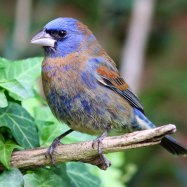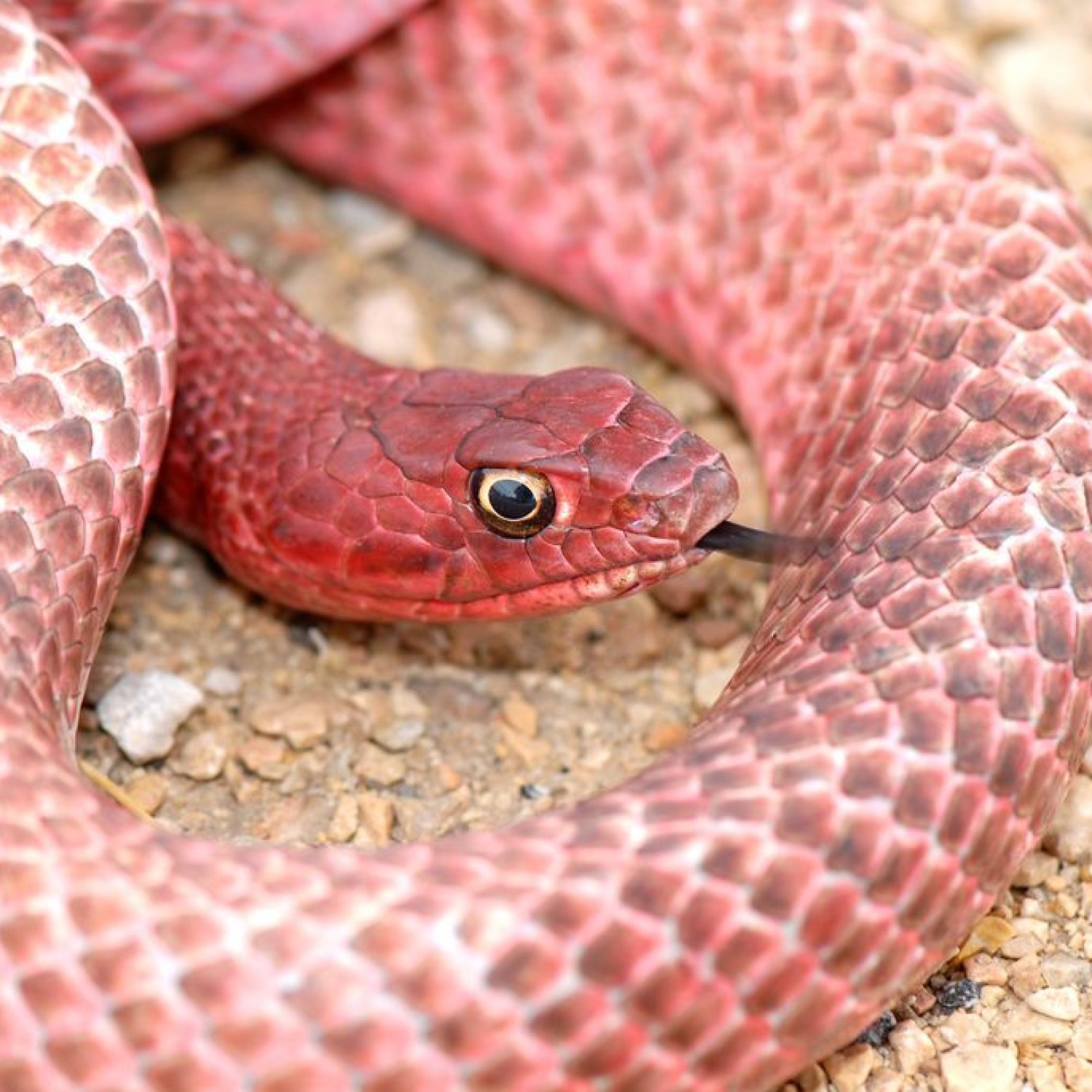
Coachwhip Snake
4 to 8 feet (1.2 to 2.4 meters)
The Coachwhip Snake, found in diverse habitats from deserts to forests, is a slender and elongated serpent that can grow up to 8 feet long. Belonging to the Colubridae family, this elusive animal is known for its lightning-fast movements and unique hunting techniques. Keep your eyes peeled for this fascinating creature on your next outdoor adventure!
Animal Details Summary:
Common Name: Coachwhip Snake
Kingdom: Animalia
Habitat: Deserts, grasslands, scrublands, and forests
The Coachwhip Snake: A Fascinating Creature of North America
When thinking of snakes, many people often picture the stereotypical large, intimidating species such as the anaconda or the king cobra. However, North America is home to a variety of snakes that may not be as well-known but are just as fascinating. One of these creatures is the coachwhip snake, scientifically known as Masticophis flagellum. This slender, elongated species can be found in a wide range of habitats and has many unique characteristics that make it stand out among other snakes Coachwhip Snake. In this article, we will take a closer look at the coachwhip snake, exploring its habitat, feeding habits, physical characteristics, and more.Origin and Distribution
Coachwhip snakes are native to the United States, Mexico, and Central America. In the United States, they can be found in various states such as California, Arizona, Texas, and Florida. They have also been spotted in parts of Kansas, Nebraska, and Oklahoma. In Mexico, they are primarily found in the northern states, while in Central America, they can be found in Honduras, Nicaragua, and Guatemala.
Habitat and Adaptations
One of the most remarkable qualities of the coachwhip snake is their ability to adapt to a wide range of habitats. They are commonly found in deserts, grasslands, scrublands, and forests. This adaptability is due to their excellent climbing, burrowing, and swimming abilities. They can often be seen basking in the sun on tree branches or on rocks, and they are also great at camouflaging themselves in their surroundings Collared Peccary.
Feeding Habits
Like many other snakes, coachwhip snakes are carnivorous and feed on a variety of small animals such as rodents, birds, lizards, and insects. They are skilled hunters and use their quick movements and excellent vision to catch their prey. Coachwhip snakes are also known to be opportunistic and will eat carrion or take advantage of any easy food sources they come across.
Physical Characteristics
The coachwhip snake gets its name from its slender and elongated body, which can range from 4 to 8 feet in length. They have a smooth, glossy appearance and are typically reddish-brown, tan, or gray with a lighter colored belly. However, the coloration of coachwhip snakes can vary greatly, and there have been sightings of individuals with black, yellow, or even blue scales.
Their slender body and smooth scales make them incredibly agile and fast-moving. They can reach speeds of up to eight miles per hour, making them one of the fastest snakes in the world. This speed, combined with their ability to climb and burrow, makes them master escape artists when faced with predators.
Behavior and Reproduction
Coachwhip snakes are diurnal creatures, meaning they are most active during the day. They are solitary and not known to be aggressive towards humans, but they will defend themselves if threatened. When threatened, coachwhip snakes will rattle their tail in dry leaves or make loud hissing noises to intimidate predators.
In the spring and summer months, coachwhip snakes will mate and then lay their eggs in a secluded area. The eggs will hatch after two to three months, and the young snakes will be on their own immediately. After hatching, they are fully independent and will have to fend for themselves as they grow and develop.
Conservation Status
According to the IUCN Red List of Threatened Species, the coachwhip snake is currently listed as a species of least concern. While they may face threats such as habitat loss and being killed by humans, their adaptability and large range have allowed them to thrive in various environments. However, it is always essential to be mindful of sharing their habitats and to respect these creatures in their natural environment.
In Conclusion
The coachwhip snake is a remarkable creature with many unique qualities that make it stand out among other snakes. From its ability to adapt to various habitats to its impressive speed and striking coloration, the coachwhip snake is a fascinating species to observe and learn about. As they continue to thrive in their natural habitat, we should strive to understand and appreciate these incredible creatures and the vital role they play in our ecosystem.

Coachwhip Snake
Animal Details Coachwhip Snake - Scientific Name: Masticophis flagellum
- Category: Animals C
- Scientific Name: Masticophis flagellum
- Common Name: Coachwhip Snake
- Kingdom: Animalia
- Phylum: Chordata
- Class: Reptilia
- Order: Squamata
- Family: Colubridae
- Habitat: Deserts, grasslands, scrublands, and forests
- Feeding Method: Carnivorous
- Geographical Distribution: North America, primarily in the United States, Mexico, and Central America
- Country of Origin: United States, Mexico
- Location: Coachwhip snakes can be found in a wide range of habitats, including deserts, grasslands, scrublands, and forests.
- Animal Coloration: Varies, typically reddish-brown, tan, or gray with a lighter belly
- Body Shape: Slender and elongated
- Length: 4 to 8 feet (1.2 to 2.4 meters)
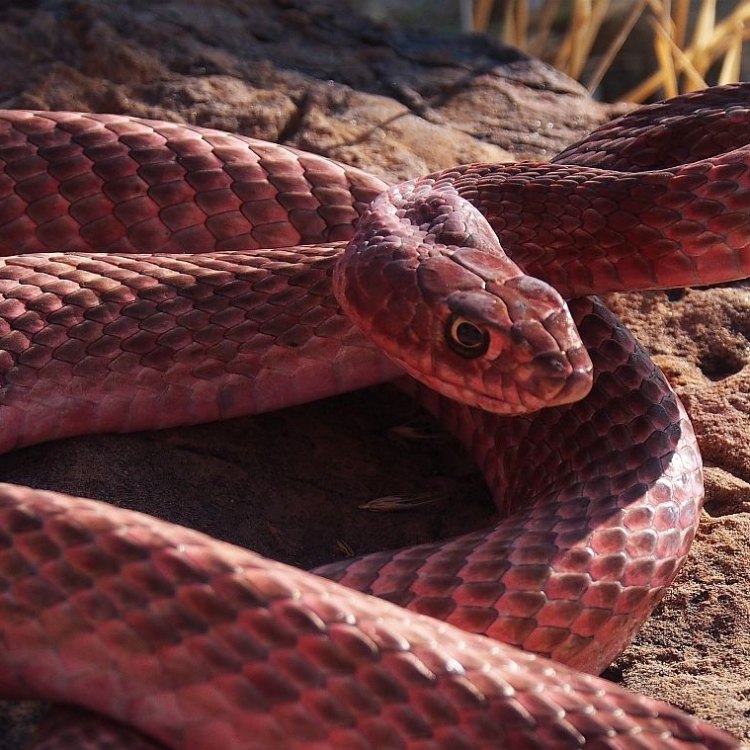
Coachwhip Snake
- Adult Size: Adult coachwhip snakes can reach lengths of 4 to 8 feet (1.2 to 2.4 meters).
- Average Lifespan: 10 to 12 years
- Reproduction: Sexual
- Reproductive Behavior: Coachwhip snakes mate in the spring and lay their eggs in early summer. The eggs hatch after an incubation period of about 60 days.
- Sound or Call: Coachwhip snakes are quiet and usually do not produce vocalizations.
- Migration Pattern: Coachwhip snakes do not typically migrate long distances.
- Social Groups: Coachwhip snakes are solitary animals and do not form social groups.
- Behavior: Coachwhip snakes are fast and agile hunters. They are known for their quick movements and ability to climb trees. They are diurnal, meaning they are active during the day.
- Threats: The main threats to coachwhip snakes include habitat loss, road mortality, and persecution by humans.
- Conservation Status: Least Concern
- Impact on Ecosystem: Coachwhip snakes play an important role in controlling populations of their prey species, which include rodents, lizards, and birds.
- Human Use: Coachwhip snakes are not commonly used by humans for any specific purposes.
- Distinctive Features: Coachwhip snakes have long, slender bodies and are known for their speed and agility.
- Interesting Facts: 1. Coachwhip snakes are one of the fastest snake species, capable of speeds up to 13 miles per hour (21 kilometers per hour). 2. They are excellent climbers and can even climb trees. 3. Coachwhip snakes are non-venomous and rely on their speed and agility to catch prey. 4. They are known for their ability to quickly whip their bodies in a snapping motion when threatened. 5. Coachwhip snakes are also called whip snakes or red racers.
- Predator: Coachwhip snakes have a few natural predators, including birds of prey, larger snakes, and mammals.
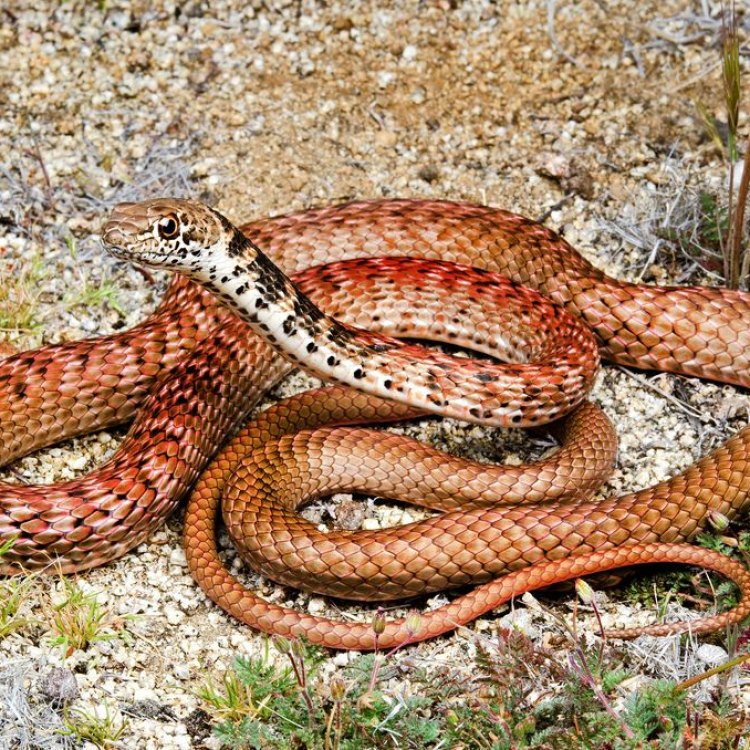
Masticophis flagellum
The Mysterious and Mighty Coachwhip Snake: Fast, Agile, and Essential to the Ecosystem
The coachwhip snake is a fascinating and elusive species that roams the dry, open areas of the United States and Mexico. Its long, slender body and remarkable speed has captivated the imagination of many, making it a popular subject among snake enthusiasts and researchers alike.In this article, we will delve into the unique features and characteristics of the coachwhip snake, exploring its behavior, role in the ecosystem, and threats to its existence.
The Physical Characteristics of the Coachwhip Snake
The coachwhip snake, also known as whip snake or red racer, is a non-venomous species that belongs to the Colubridae family PeaceOfAnimals.Com. It is primarily found in the southern and western parts of the United States, as well as in certain regions of Mexico. Measuring between 4 to 8 feet (1.2 to 2.4 meters) in length, adult coachwhip snakes can reach impressive speeds of up to 13 miles per hour (21 kilometers per hour).One of the most distinctive features of the coachwhip snake is its long, slender body, which allows it to move swiftly through its environment. It also has a shiny, reddish-brown color, with some variations in shades, making it well-camouflaged in the desert landscape.
Despite its name, the coachwhip snake does not have a whip-like tail. Its tail is simply long and thin, just like the rest of its body. However, it is known for its quick movements and the ability to quickly whip its body in a snapping motion when threatened Cross Fox. This behavior has given it its name and adds to its mysterious nature.
The Life and Reproduction of Coachwhip Snakes
Like most snakes, coachwhip snakes are solitary creatures and do not form social groups. They are diurnal, meaning they are most active during the day. They prefer dry, open areas such as deserts, grasslands, and scrublands.Coachwhip snakes are sexual reproducers, meaning they require a male and female to mate. They usually mate in the spring and lay their eggs in early summer. The female coachwhip snake can lay anywhere between 4 to 20 eggs, which hatch after an incubation period of about 60 days.
The hatchlings are approximately 12 inches (30 centimeters) long and have the same color as the adults. They are independent from birth and can fend for themselves.
The Coachwhip Snake's Behavior and Hunting Techniques
Coachwhip snakes are fast and agile hunters, capable of chasing prey on both the ground and in the air. They are also excellent climbers and can even climb trees. Their diet consists mainly of rodents, lizards, birds, and their eggs.The coachwhip snake's hunting technique is unique and fascinating to watch. They use their remarkable speed and agility to chase after their prey and catch them with their mouths. They also use their whip-like body to confuse and disorientate their prey, making it easier to catch them. Their quick movements and reflexes have earned them a reputation as one of the fastest snake species in the world.
The Importance and Impact of Coachwhip Snakes in the Ecosystem
Coachwhip snakes play a crucial role in their ecosystem as they help control populations of their prey species. By keeping the numbers of rodents, lizards, and birds in check, they help maintain a healthy balance in the ecosystem.Additionally, they also act as a food source for larger snakes, mammals, and birds of prey. Their ability to climb trees and hunt in the air also makes them essential for controlling bird populations in certain areas.
The Threats to Coachwhip Snakes and their Conservation Status
Unfortunately, coachwhip snakes face several threats to their existence. The main threat is habitat loss due to human development, agriculture, and urbanization. As these snakes prefer dry, open areas, their habitats are often destroyed or degraded, leaving them with less space to roam and hunt.Road mortality is another significant threat to coachwhip snakes. As they are diurnal and active during the day, they often cross roads, making them vulnerable to getting hit by vehicles. This is especially true in areas where human activity is high.
Persecution by humans is also a significant threat to coachwhip snakes. Many people have a fear or misunderstanding of snakes, leading to them being killed out of fear or ignorance.
Despite these threats, the conservation status of coachwhip snakes is currently listed as least concern on the International Union for Conservation of Nature (IUCN) Red List. However, continuous efforts must be made to monitor their populations and mitigate the threats they face.
The Human Use and Cultural Significance of Coachwhip Snakes
Unlike many other snake species, coachwhip snakes are not commonly used by humans for any specific purposes. They are not sought out for their skin, meat, or venom. However, they do hold cultural significance in some Native American cultures, where they are revered as symbols of fertility and renewal.In some regions, coachwhip snakes are also kept as pets by snake enthusiasts. However, caution must be taken as these are wild animals and require specialized care, diet, and environment.
Interesting Facts about the Coachwhip Snake
1. Coachwhip snakes are one of the fastest snake species, capable of speeds up to 13 miles per hour (21 kilometers per hour).2. They are excellent climbers and can even climb trees.
3. Coachwhip snakes are non-venomous and rely on their speed and agility to catch prey.
4. They are known for their ability to quickly whip their bodies in a snapping motion when threatened.
5. Coachwhip snakes are also called whip snakes or red racers.
Predators of Coachwhip Snakes
Like any other species, coachwhip snakes have a few natural predators, including birds of prey, larger snakes, and mammals. They use their quick movements and agility to evade these predators and also rely on their camouflaged coloration to stay hidden.In Conclusion
In conclusion, the coachwhip snake is a magnificent and unique species that holds an important place in its ecosystem. Its speed, agility, and hunting techniques make it a subject of fascination and research among snake enthusiasts. However, their populations are facing threats, making it essential for us to understand and protect this mysterious and mighty species for future generations to admire and learn from.
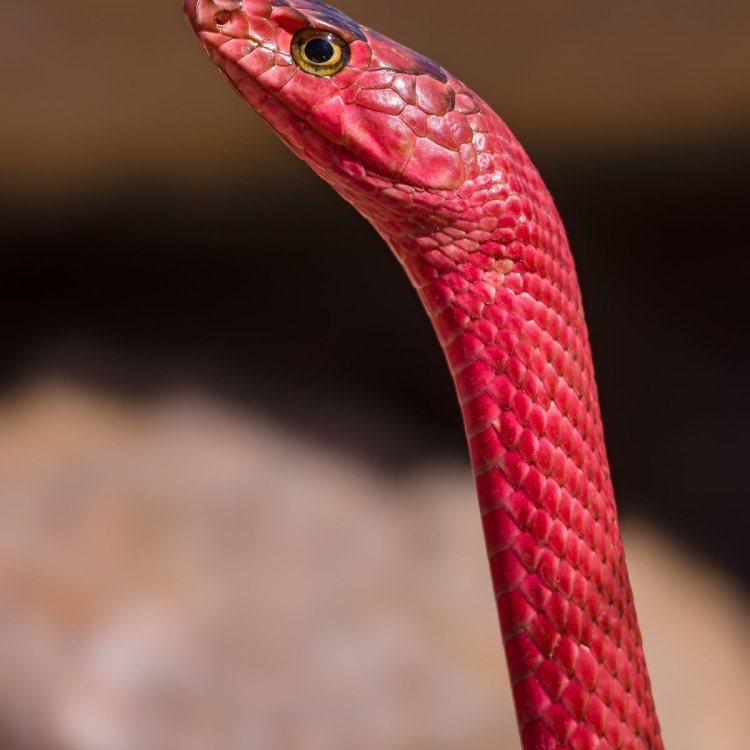
The Coachwhip Snake: A Fascinating Creature of North America
Disclaimer: The content provided is for informational purposes only. We cannot guarantee the accuracy of the information on this page 100%. All information provided here may change without prior notice.





